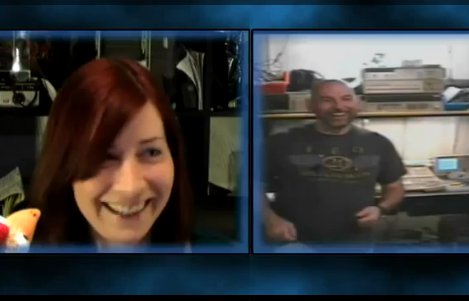[Jeri Ellsworth] and former Commodore Computer engineer and current full time tinkerer [Bil Herd] have a little chat on skype covering the 101’s of Phase Lock Loops in this hour long video. PLL’s are handy for many applications, but their basic use is to keep clock signals in sync.
Topics covered include: Why we care, a basic explanation for the CD4046, capture ranges, and meta stability. Examples from analog tv, to clock recovery, finding falling edges and FPGA’s. This thing is jam packed full of information.
With talks of future episodes and a quick tour of [Bil’s] bench this is something to not miss. Join us after the break for the video!
















really cool. A wealth of knowledge from two very insightful people
rambling, but in a very amusing and informative way. Seriously makes me wonder what kind of crazy stuff the modern pc gets up to before i even see the bios on screen.
Neat.
Everyone remember The Broken? Haha, I miss that shit.
@Alex Parting
Dude, what the hell?!?
Really good video. At the start I didn’t know really very much at all but they explained each thing clearly as they went through and fealt I learnt way more in that video that in a whole week of Systems (electronics) lessons at college haha.
@Alex: True hotness is making transistors from scratch and emulating (and selling!) a C64 in an ASIC.
4046 is the 555 of PLLs, very versatile and cheap, but it shows its age and it’s about time people start using its more modern successor, the 74HCT4096. Think about a *much* stabler 4046 with more features and nearly identical pinout.
Now if only there were more sources for this chip in DIP package.
@Roman Really? we cant get beyond the physical at all here eh? How about a FUCKIN AWESOME PERSON? is that enough? pigs hating pigs up in here…
HaHa! Great timing (no pun intended)
http://dev.haiku-os.org/browser/haiku/trunk/src/add-ons/accelerants/radeon_hd/pll.cpp#L72
LOL at all the white knights here.
yea I think he’s awwesome. should make more video’s.
I like them both talking about this kind of digital and analog stuff. Definitly take a second look at this when back to skool.
bout Jeri, she’s Hot. more like the things she do, but also a bit in looks. But what am i talking, I have a GF. And maybe, just maybe Jeri may read this to. I like people teaching things they know, ill do the same thanks to people like Jeri and Bil.
hello, I can not find any info about the “74HCT4096” PLL that was mentioned. anyone want to share a link to a data sheet or product number that actually shows up when googled? thanks
Unfortunately, not a very structured discussion.
A/V quality unbearable at times.
Very nervous guy (constantly moving around).
Thanks for the effort, though.
Relay this comment to youtube, will you.
there`s an interesting article in this months Practical Wireless that features the 74hc4046 as a Pll VFO.
the circuit looks simple enough and easily modifiable too ;)
Not a very good explanation of PLLs. I missed the fundamental point a PLL is a feedback loop and how feedback loops work. A PLL is a cybernetic circuit which is similar to feedback loops in nature. If you don’t understand feedback loops you can’t understand PLLs.